Exhibition
Museum of Fine Arts, Boston
May 1 – September 11, 2022
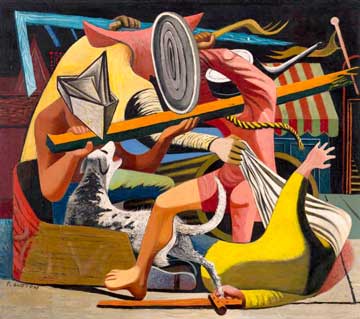
by Philip Guston
Image: Courtesy of Museum of Fine Arts, Boston
Philip Guston (born Philip Goldstein, 1913-1980) was a painter who explored a range of styles over a long career, with earlier works that tended towards the semi-representational and surrealistic, and later works that ranged from pure abstractions to amalgamations of disparate icons. Some of the imagery Guston employs is disturbing, especially because it is presented almost without context, as though the viewer were meant to absorb the significance of these red flags automatically. In this vein, varied emblems of the Holocaust repeat in different ways throughout his work, and there are on repeated occasions, with perhaps less contextual comprehensibility or external reference, images of Ku Klux Klan garb, most often and specifically, KKK head coverings or hoods.
Though those Klan hoods are not represented in any glorifying way, their mere presence is controversial. That imagery, along with other complications due to the COVID pandemic, led in 2020 – when this exhibition was originally meant to be kicked off – to be delayed for one year. On May 25, 2020, shortly before that earlier scheduling of an opening of the show at the National Gallery in Washington DC in June of that year, George Floyd had been murdered in Minneapolis, leading to a huge national outcry and major demonstrations in cities across the US. On July 25 of that year, the curators of the exhibition and the museum directors of the multiple museums which have sponsored it – which, in addition to Boston’s MFA and the National Gallery include the Museum of Fine Arts (MFA) Houston and London’s Tate Modern – decided that it would be best to delay the opening for a year due, specifically, to the pandemic, with a projected start the Tate Gallery in London. On September 22 the exhibition was postponed to 2024, with specific reference to the complexities of Guston’s imagery and the need to rethink the nature of the presentation. Soon after, on November 5, a revised tour schedule was announced, with the exhibition debuting at the Museum of Fine Arts, Boston on May 1, 2022. The current exhibition represents that rethinking and is designed in such a way to offer considerable support to the viewer in approaching and understanding this difficult and sometimes confusing imagery.
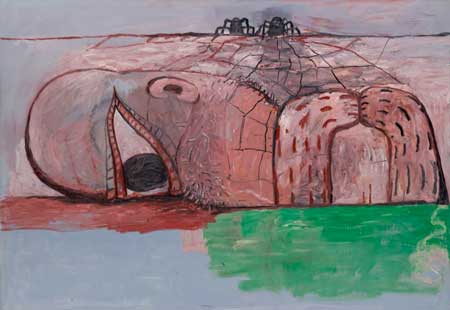
by Philip Guston
Image: Courtesy of Museum of Fine Arts, Boston
The exhibition, as a result, is structured thematically rather than chronologically, with supporting narratives to give a sense of what Guston is up to in each category of work. The result is a presentation of Guston’s work in its resplendent variety throughout the exhibition. The show is not therefore specifically geared to give a clear sense of the linear development or trajectory of Guston’s work, but rather to give a sense of the intermingled complexity of Guston’s sources of inspiration and the power of his vision. The title of the exhibition – Philip Guston Now – gives a sense of what the curators are up to in this regard – to present the wide variety of Guston’s work and to offer a greater contemporary awareness to the complexity of its imagery with a mind to help support making sense of its difficulties.
Despite this lack of chronological ordering, the first couple of galleries do include a preponderance of Guston’s early work which is quite interestingly detailed and complex. With some element of figuration, these paintings give a sense of an artist wrestling with surrealist impulses, and urging towards an integration of multiple images without giving clear thematic reference. They are indeed appealing and impressive, and give a good sense of Guston’s capacity to work closely with line and field to create impressive amalgams.
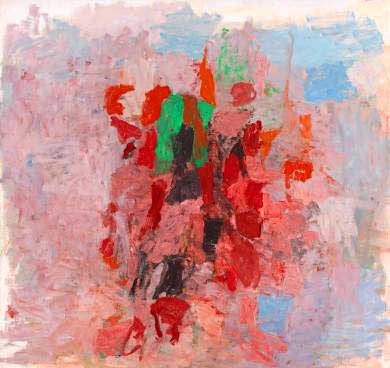
by Philip Guston
Image: Courtesy of Museum of Fine Arts, Boston
As one proceeds through the galleries, arrays of work from other periods of Guston’s career emerge. There are quite a few pure abstractions in the Abstract Expressionist mode, though not as gracefully gestural as Pollock’s nor as spaciously poetic as Rothko’s. Rather, they are tighter renderings of painted layers that signify accretion rather than dance. They do not express movement nor reach to corners of dream; rather, they give a sense of a kind of internal explosion, an underground detonation.
This kind of explosive containment reveals itself throughout Guston’s work. Sometimes, the effect is atomic and fragmentary, with series of singular images that array themselves on an otherwise vast empty canvas. Other times it is intense, with a singular and focal image or set of images wrought in what seems like a combined state of irony, exploration and desperation. Those vivid images, grand and obtuse, remind one a bit of the German Expressionists Beckmann, Grosz, Dix and Marc, who seek their Expressionism through arrays of colored imagistic figuration that press on the edges of emotional distress. Interestingly, though Guston makes moves in the direction of Abstract Expressionism, his most forceful work emanates from that other, earlier, Germanic form of representational Expressionism.
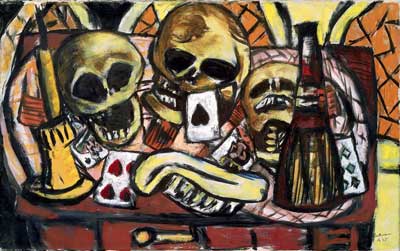
by Max Beckmann
Image: Courtesy of Museum of Fine Arts, Boston
Some of these semi-imagistic constructions call out the Holocaust, with arrays of shoes and legs piled on one another in repeated display. With a durable repeated series of explorations like Picasso pursued in his Weeping Woman series of 1937 repeated endlessly in canvas after canvas, Guston’s legs and shoes repeat endlessly in canvas after canvas as a constant refrain of the theme of loss and destruction.
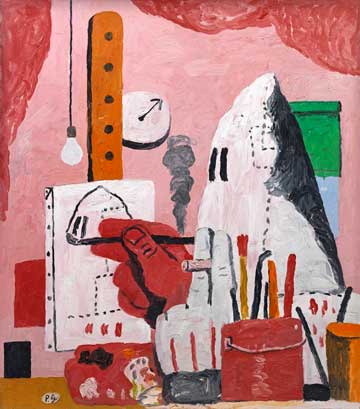
by Philip Guston
Image: Courtesy of Museum of Fine Arts, Boston
It is in this context that one best understands Guston’s use of the KKK hood image. That also repeats in canvas after canvas, and one might think as a result of seeing this endless repetition that was Guston bizarrely obsessed. But the repetition of the shoes as an emblem of the concentration camps during the Holocaust is a signal that Guston’s constant and repeated invocation of the KKK hood is a kind of artistic return of the repressed – to invoke the Freudian image – or perhaps a form of emotional self-flagellation, and, in a more open sense, a form of artistic investigation. That combination of influences and inspirations could certainly be applied to Picasso’s Weeping Woman and it is not irrational to see that combination in Guston’s work. Pursued repeatedly, these images vary somewhat and suggest something slightly different at each turn. In one case, the emblem of the KKK hood is solitary, in another, multiple, and in yet another, erased by a supervening layer of paint.
A helpful quote posted by the curators helps to understand Guston’s obsession, declaring his own feeling of feeling like was sometimes living inside a hood. That is indeed a loaded statement, but one that might very well have been prescient, something about the contained and covert in itself, the nature of impulse to hide and explode within a shielded exterior. Because of the ambiguity of his imagery and reference to these hoods, a range of interpretations is possible: potentially suggestive of his self-awareness of a subliminal form racism, with, one would expect, a sense of confused shame about it. But, as well, he might simply be suggesting horror at what the KKK hood implies; as some of his autobiographical notes indicate he was from an early age traumatized and obsessed with what the KKK represented. One expects that Guston’s response falls somewhere between self-awareness and horror, but it is hard to tell. Whatever the implications, the imagery is unsettling and integrally written into the script of Guston’s intense complexity.
Ambiguity prevails throughout Guston’s work, and, in this sense, the curators of the exhibition have sought to present it with everything included but without presuming a declaration of intent. Guston’s work is powerful and suggestive enough to provide a probe of difficult themes. In this sense, the curators have offered up that subject-matter with an appropriate recognition that the Holocaust or KKK images may not be suitable for everyone’s viewing.
Several videos are included in the show: a roundtable of the visibly diverse panel of curators and advisors at the MFA discussing their views of Guston, the challenges of the exhibition and the choices before them; and, as well, there is a roundtable of former students of Guston’s during his time in the 1070s as a professor at Boston University who look back on his influence, mentorship and artistry.
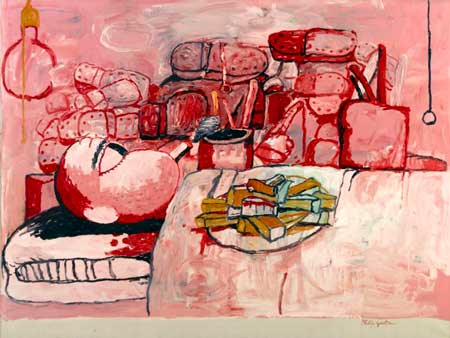
by Philip Guston
Image: Courtesy of Museum of Fine Arts, Boston
In the end, one comes to the sense of a powerfully unsettled, sometimes inspired, artistic explorer. Almost improvisational at times, his work suggests possible directions rather than pointing the way to them. But when, especially in some of his vivid, graphic, lurid images that seem to trace most persuasively to the German Expressionists, these energies come together with force and eloquence. Those are the points at which Guston’s early display of graphical competence and his later display of imagistic improvisation come together in a more contemporary form of what Beckmann, Dix and company tried to do earlier in the century. The overall effect is unsettling and sometimes transfixing.
– BADMan (aka Charles Munitz)
Leave a Reply